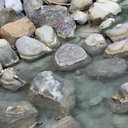Antioxidant activity of organic and aqueous leaf extracts of Cassia occidentalis L. in relation to their phenolic content.
Schlüsselwörter
Abstrakt
In this study, the antioxidant potency of sequential organic and aqueous leaf extracts of Cassia occidentalis was investigated, employing various established in vitro systems such as nitric oxide scavenging (NOS) activity, β-carotene-linoleic acid model system, hydroxyl radical scavenging (HRS) activity, reducing power, metal chelating activity (MCA) and superoxide radical scavenging (SRS) activity. The aqueous extract of the leaves of C. occidentalis was found to be most effective against free radicals, followed by the methanolic, chloroform, petroleum ether and benzene extracts, respectively. A preliminary study of qualitative and quantitative estimations of phenolics was performed, and the results were correlated with different antioxidant tests. A positive and significant (p < 0.05) correlation was observed (R² = 0.42 to 0.96) between various test systems, and the results on total phenolics showed that the phenolic compounds were responsible for the antioxidant capacity of the extracts. This study also showed that phenolics may contribute maximally to HRS (R² = 0.9236) and MCA (R² = 0.9396) and to a lesser extent to NOS activity (R² = 0.5819) and the β-carotene-linoleic acid assay (R² = 0.8213). The data obtained in the in vitro models clearly establish the antioxidant potency of leaf extracts of C. occidentalis.




